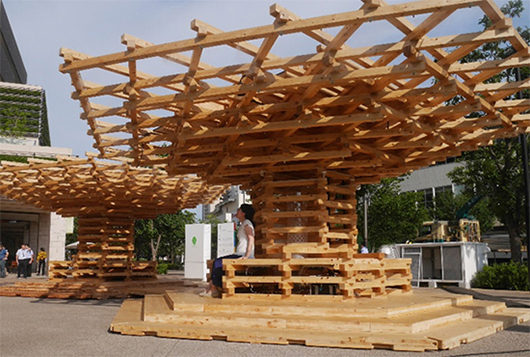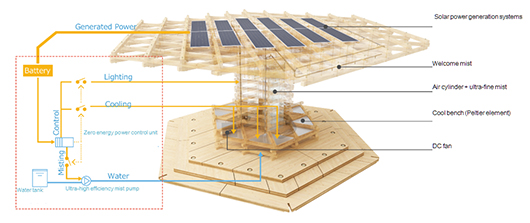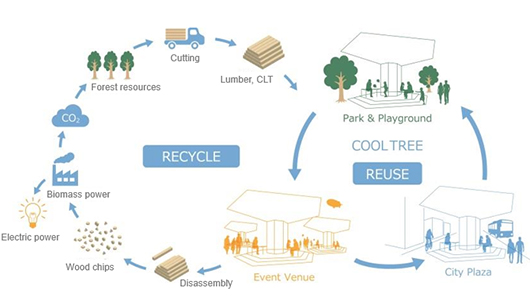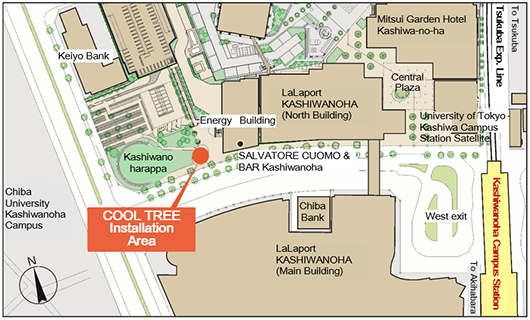A Cool Spot with Zero City Energy Consumption
First “COOL TREE” Installation at Kashi-no-ha Smart City
July 20, 2018
Mitsui Fudosan Co., Ltd.
Nikken Sekkei Ltd.
Tokyo, Japan, July 20, 2018 - Mitsui Fudosan Co., Ltd., a leading global real estate company headquartered in Tokyo, announced today that Mitsui Fudosan and Nikken Sekkei Ltd. installed the first “COOL TREE,” a cool spot that provides comfort in a metropolitan area affected by the urban heat island phenomenon, at Kashiwano Harappa, a community plaza within Kashiwa-no-ha Smart City in Kashiwa City, Chiba Prefecture.
COOL TREE creates cool spots in outdoor public spaces with the combination of environmental performance and design excellence with zero city energy consumption. It was developed by Nikken Sekkei Ltd., MEIKEN LAMWOOD CORPORATION, Ltd., Koei Co., Ltd., and Murata Manufacturing Co., Ltd. with the purpose of contributing to urban development for comfortable outdoor living in midsummer. (*Patent, design and trademark registrations are currently pending.)
Kashiwa-no-ha Smart City, a public-private-academic project in which Mitsui Fudosan is taking part, advances a form of urban development aimed at solutions to problems the world is facing. “An Environmental-Symbiotic City” is one of its key urban development concepts, alongside “A City of New Industry Creation” and “A City of Health and Longevity,” and the project represents the attempt to realize these concepts through urban design with ample water and greenery. COOL TREE aligns well with this approach to urban development, so it was installed at the site ahead of the project’s full-fledged development beginning next summer. Quantitative operational data will be collected and analyzed and feedback from local visitors to the plaza will be incorporated to further enhance performance.

COOL TREE (at Kashiwano Harappa)
COOL TREE Features
- Three forms of “cool” to recreate forest therapy
(1) Lattice sunshade made from hinoki cypress to block direct sunlight
(2) A bench that uses the Peltier effect(*1) to cool you as you sit
(3) Cooling mist that activates via a sensor when someone approaches
- True hexagon shape that can be flexibly arranged based on the site
- Self-sufficient system that uses solar power and IoT control for zero city energy consumption
- Can be set up easily in as little as one day and repeatedly reused in various locations
- Utilizes thinned wood from forests in Japan and cross-laminated timber (CLT); later to be recycled as biomass power
*1 Peltier effect: When different metals are joined and voltage applied to produce a current, heat is absorbed and released at the junction points

COOL TREE Functions and Power System Diagram
Click Illustration to enlarge
1. Three forms of “cool” to recreate forest therapy
(1) The lattice hinoki sunshade has an open feel but blocks direct sunlight like a tree canopy to lower the surface temperature in the immediate area.
(2) The cooling bench uses the Peltier effect to make the bench seat cool to the touch. Just sitting on the bench gives you a chilled feeling, and it can cool your body down.
(3) A sensor detects when people approach and activates mist of relatively large droplets sprayed from the edge of the eaves. This cools the air via vaporization heat while providing a visual sense of cooling down. In addition, when sitting on the cool bench, an ultra-fine mist that does not attach water droplets to the body is delivered to the neck and back on slight airflow from the air cylinder embedded in the base portion of the backrest.
Utilizing tree shade, the cooling bench and mist together create the sense of “urban forest therapy,” and in the simulation at the testing stage, the air temperature perceived by participants was lowered by approximately 5℃ on average.
2. True hexagon shape that can be flexibly arranged based on the site
With a height of approximately 10 ft (3 m) and diameter of approximately 25 ft (7.7 m), the form is “one-legged” like a tree to provide an open feel without enclosing the area. Further, the shape is a hexagon so multiple units can be connected and combined in a honeycomb configuration to allow for flexible scalability based on the shape of the installation location.
3. Self-sufficient system that uses solar power and IoT control for zero city energy consumption
Solar panels are installed above COOL TREE’s sunshade lattice, so the power driving the cooling devices like the cool bench and mist all derives from solar energy (approx. 10 kWh/day on clear days).
Innovations in efficient energy conservation are necessary to achieve a zero energy system that is completely independent of the city energy infrastructure. Power from the solar panels is stored in storage batteries (2.5 kWh) and used when COOL TREE devices are activated by the motion sensor or temperature and humidity sensor. The control system, the mechanism for efficiently generating the ultra-fine mist, and other technologies were newly developed for the project.
4. Can be set up easily in as little as one day and repeatedly reused in various locations
COOL TREE was created with a simple, layered structure and the various parts are joined using only bolts. This make it possible to assemble and disassemble in as little as a day, so it can be set up repeatedly in different locations over a short period of time, such as for events of a limited duration. (The current installation is scheduled to remain in Kashiwa-no-ha Smart City until September 2019, in order to confirm outdoor durability and other features.)
5. Utilizes thinned wood from forests in Japan and cross-laminated timber (CLT); later to be recycled as biomass power
Wood products store carbon dioxide absorbed during their growth as trees for the long term and do not release it into the atmosphere, which makes wood an environmentally friendly material. COOL TREE utilizes thinned wood from Japanese forests, so the energy used in its production is especially low. The foundation, which functions as a weight for the whole, is made with cross-laminated timber (CLT) (*2), promoted in recent years as a way to effectively utilize forest resources. The parts are reused to prevent the release of carbon dioxide over the long term, so there is no new carbon dioxide emitted that would impact the environment. Also, when the parts are finally disposed after reuse, they are planned to be crushed into wood chips and recycled for use in biomass power generation.
Carbon dioxide emissions are reduced to the maximum extent throughout COOL TREE’s lifecycle, from material procurement to usage and disposal, which is for the aim of achieving carbon neutrality (*3) in which a balance is maintained with the amount of carbon dioxide absorbed by forest resources.
*2 Cross-laminated timber is a wood product in which laminar panels oriented perpendicular to each other are layered and joined together. The large, thick boards that result are used in architectural structures, civil engineering projects, furniture and other applications.
*3 Carbon neutrality: Because the carbon dioxide emitted during plant combustion or biodegradation was originally carbon dioxide in the atmosphere that was absorbed through photosynthesis, the amount of atmospheric carbon emitted balances out to zero (neutral).

COOL TREE Reuse/Recycle Concept Diagram
Little by little, it is becoming more difficult to spend time safely and comfortably in outdoor spaces during the summer in cities in Japan and other countries where the urban heat island phenomenon continues to be an issue. By mitigating the heat with COOL TREE’s environmental technologies, the aim is to create places in the open and airy outdoors where people would want to gather and thereby contribute to the formation of local communities.
Map of current site (installation area)

Click Map to enlarge